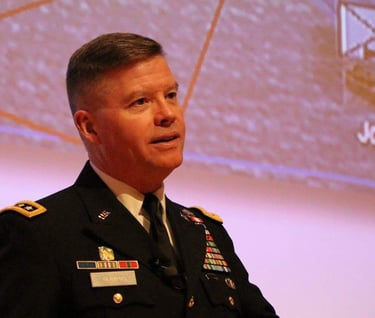Making the Military
Gen. David G. Perkins, U.S. Army Training and Doctrine Command, says he designs the Army by strategizing what the country's national defense system needs in a complex world. That means leaving behind defense paradigms from the past.
GOVERNMENT


U.S. Army general tells Utah crowd how he builds leaders
SALT LAKE CITY, Utah – New York City has fashion designers and department stores have window designers. Additionally, the Army has a "designer," Gen. David G. Perkins, U.S. Army Training and Doctrine Command (TRADOC), a wholly-owned subsidiary of the U.S. Army that recruits, trains and educates U.S. soldiers and civilian Army employees.
Perkins, the commanding general for TRADOC, spoke to 167 people, including local members of the military, Tuesday, Feb. 7, at the Jewett Center for the Performing Arts, Westminster College. He was in Utah as a guest lecturer for the Utah Council for Citizen Diplomacy (UCCD) as part of its World Affairs Lecture Series. During his lecture, "Developing Leaders to Succeed on an International Stage," Perkins said that he designs the Army beginning with strategizing about what the country's national defense system needs in a complex world. That means, he said, leaving defense paradigms from the past behind.
"What we do is we look out to 2025 and 2050 and we try to describe what political situations we'll face around the world," said Perkins. "What are the demographics, what are the economics, what are the challenges we're going to face, what are the competitors we're going to face and what are the things that our potential adversaries are possibly going to do to us? Then once we have that all figured out, then we go about designing the Army. Then we basically put together a blue print for the next 30 years."
Perkins is responsible for 47,452 Army employees at 1,634 locations worldwide, and 500,000 students, annually, in Army universities and schools. "We design the Army, we go out and acquire the Army we design, which is recruiting, and then we build the Army we acquired. Then we constantly improve what we built. So that's what keeps us busy until noon on most days," he said, bringing laughter to the audience.
During his lecture, Perkins also allowed time for questions from the audience. He was the fifth lecturer in a six-part series concluding next month. The series included other speakers from a wide range of professions. Kathy Laurini, senior advisor, Exploration and Space Operations, NASA, will conclude this year's lecture series.
"This is the 10th year we've done this lecture series but very few people know about it," said Felecia Maxfield-Barrett, UCCD communications and events director, about the free series, which is open to the public. "What we really want to do is get people to listen to these topics and start thinking critically about global affairs in a global society but which have a local impact here in Utah."
